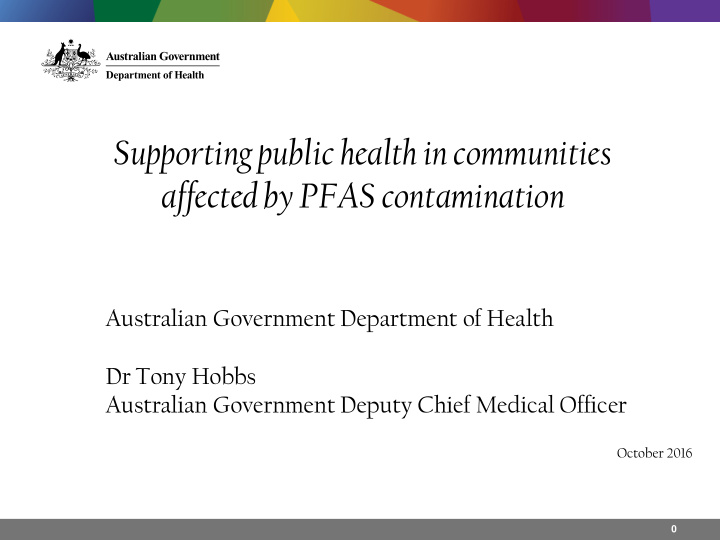



Supporting public health in communities affected by PFAS contamination Australian Government Department of Health Dr Tony Hobbs Australian Government Deputy Chief Medical Officer October 2016 0
Key activities to support communities affected by PFAS • Provide health “standards” for PFAS exposure. • Ensure potential adverse human health effects are better understood through an epidemiological study. • Provide access to blood tests for PFAS for those who want them. • Ensure access to health services that are able to support people who are stressed or anxious as a result of PFAS contamination and the uncertainty about health effects. 1
Human health standards for PFOS and PFOA Environmental Health Standing Committee of the Australian Health Protection Principal Committee • Before June 2016 there were no Australian human health standards for PFOS and PFOA. • In June 2016, enHealth made recommendations on interim standards that could guide the Human Health Risk Assessments at contaminated sites. • Standards were needed so that authorities could provide advice to communities while more work was undertaken. 2
What did enHealth recommend? Environmental Health Standing Committee of the Australian Health Protection Principal Committee • enHealth looked at the standards developed by overseas regulatory agencies, and the methodology these agencies used. • enHealth recommended that Australia adopt the approach used in Europe because the approach is the same as used in Australia to set standards for chemicals. • The method used by the European agency is the most widely adopted internationally. 3
The enHealth standards were independently reviewed • In August 2016, the enHealth interim standards were independently reviewed by an expert in chemical regulation and toxicology. • The review found enHealth’s decision was appropriate and is protective of public health . 4
FSANZ F ood S tandards A ustralia N ew Z ealand 5
Main objectives for FSANZ In developing or reviewing Protection of public health and safety. food regulatory measures, FSANZ focuses on… Provision of adequate information to consumers. Prevention of misleading or deceptive Food Standards Australia New Zealand Act 1991 conduct.
FSANZ is now assessing PFAS • FSANZ is working on final health based guidance values that will replace the interim ones established by enHealth. • FSANZ’s work will look at potential exposure to PFAS from food at contaminated sites and the general food supply. 7
Further research is critical • The current health advice for PFAS exposure is: • There is currently no c consisten ent eviden ence that exposure to PFOS and PFOA causes adverse human health effects. Because these chemicals persist in humans and the environment, enHealth recommends that human exposure to these chemicals is minimised as a precaution ” • What this means is that the human studies to date have not consistently shown a clear link between poor health and PFAS exposure. • We need further studies to see what the health issues are in the community and if there are any links to PFAS exposure. • At the moment the uncertainty is causing stress and anxiety, which is a significant concern to health authorities . 8
An Epidemiological Study for Williamtown and Oakey • Epidemiological studies look for relationships between a potential risk to health and any unusual patterns of disease or adverse health effects. • The National Centre for Epidemiology and Population Health (NCEPH) will conduct a study in the Williamtown and Oakey communities. • Participation in the study will be purely voluntary. • Community consultation will be an important input into the study design. 9
International Agency for Research on Cancer • IARC identifies factors that can increase the risk of human cancer, including chemicals, complex mixtures, occupational exposures, physical agents, biological agents, and lifestyle factors. • Group 1: carcinogenic to humans : tobacco smoke, alcohol, processed meat, mustard gas, asbestos, arsenic; • Group 2A: probably carcinogenic to humans : DDT, glyphosate (Round-up), red meat; • Group 2B: possibly carcinogenic to humans : PFOA , petrol, talc-based body powder, chloroform; • Group 3: not classifiable as to its carcinogenicity to humans : tea, coffee, paracetamol • Group 4: probably not carcinogenic to humans : caprolactam 10
Should you get a blood test? • Blood tests cannot determine whether any medical condition is caused by PFOS or PFOA. • Blood tests do not inform the clinical advice your doctor can give you – particularly in relation to diagnosis, treatment or prognosis. • Blood tests are, however, important for the epidemiology study. 11
Voluntary blood testing for Williamtown and Oakey • Blood tests will be made available, free of charge, to those who have lived or worked in the Investigation Areas. • A pre- and post-test discussion with your GP will ensure you are given all the relevant information about the test and ensure you understand that the results will not be able to be used by your doctor to provide medical advice. • Ideally, people who volunteer for a blood test will also join the epidemiological study. 12
Additional counselling services will be available • For some, the biggest risk of becoming unwell from PFAS contamination will be through stress and worry. • We would encourage anyone who is feeling anxious or worried about the contamination to seek advice from their GP and take advantage of the counselling services available. 13
Further information. Further information is available from the Department of Health website at: www.health.gov.au/internet/main/publishing.nsf/Conte nt/ohp-pfas.htm 14
Recommend
More recommend